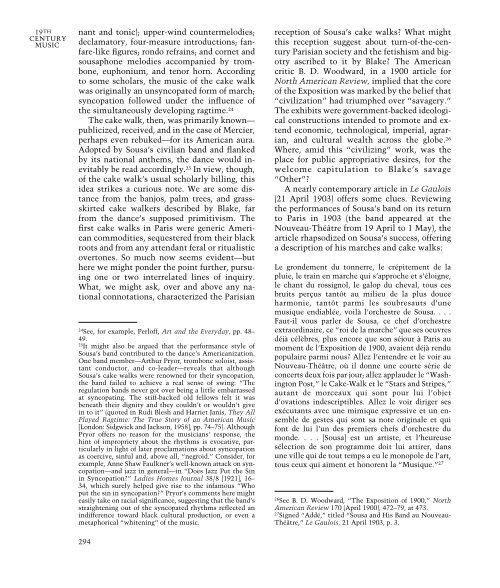Parisian Cake Walks.pdf - ResearchSpace@Auckland
Parisian Cake Walks.pdf - ResearchSpace@Auckland
Parisian Cake Walks.pdf - ResearchSpace@Auckland
You also want an ePaper? Increase the reach of your titles
YUMPU automatically turns print PDFs into web optimized ePapers that Google loves.
19TH<br />
CENTURY<br />
MUSIC<br />
nant and tonic); upper-wind countermelodies;<br />
declamatory, four-measure introductions; fanfare-like<br />
figures; rondo refrains; and cornet and<br />
sousaphone melodies accompanied by trombone,<br />
euphonium, and tenor horn. According<br />
to some scholars, the music of the cake walk<br />
was originally an unsyncopated form of march;<br />
syncopation followed under the influence of<br />
the simultaneously developing ragtime. 24<br />
The cake walk, then, was primarily known—<br />
publicized, received, and in the case of Mercier,<br />
perhaps even rebuked—for its American aura.<br />
Adopted by Sousa’s civilian band and flanked<br />
by its national anthems, the dance would inevitably<br />
be read accordingly. 25 In view, though,<br />
of the cake walk’s usual scholarly billing, this<br />
idea strikes a curious note. We are some distance<br />
from the banjos, palm trees, and grassskirted<br />
cake walkers described by Blake, far<br />
from the dance’s supposed primitivism. The<br />
first cake walks in Paris were generic American<br />
commodities, sequestered from their black<br />
roots and from any attendant feral or ritualistic<br />
overtones. So much now seems evident—but<br />
here we might ponder the point further, pursuing<br />
one or two interrelated lines of inquiry.<br />
What, we might ask, over and above any national<br />
connotations, characterized the <strong>Parisian</strong><br />
24See, for example, Perloff, Art and the Everyday, pp. 48–<br />
49.<br />
25It might also be argued that the performance style of<br />
Sousa’s band contributed to the dance’s Americanization.<br />
One band member—Arthur Pryor, trombone soloist, assistant<br />
conductor, and co-leader—reveals that although<br />
Sousa’s cake walks were renowned for their syncopation,<br />
the band failed to achieve a real sense of swing: “The<br />
regulation bands never got over being a little embarrassed<br />
at syncopating. The stiff-backed old fellows felt it was<br />
beneath their dignity and they couldn’t or wouldn’t give<br />
in to it” (quoted in Rudi Blesh and Harriet Janis, They All<br />
Played Ragtime: The True Story of an American Music<br />
[London: Sidgwick and Jackson, 1958], pp. 74–75). Although<br />
Pryor offers no reason for the musicians’ response, the<br />
hint of impropriety about the rhythms is evocative, particularly<br />
in light of later proclamations about syncopation<br />
as coercive, sinful and, above all, “negroid.” Consider, for<br />
example, Anne Shaw Faulkner’s well-known attack on syncopation—and<br />
jazz in general—in “Does Jazz Put the Sin<br />
in Syncopation?” Ladies Homes Journal 38/8 [1921], 16–<br />
34, which surely helped give rise to the infamous “Who<br />
put the sin in syncopation?” Pryor’s comments here might<br />
easily take on racial significance, suggesting that the band’s<br />
straightening out of the syncopated rhythms reflected an<br />
indifference toward black cultural production, or even a<br />
metaphorical “whitening” of the music.<br />
294<br />
reception of Sousa’s cake walks? What might<br />
this reception suggest about turn-of-the-century<br />
<strong>Parisian</strong> society and the fetishism and bigotry<br />
ascribed to it by Blake? The American<br />
critic B. D. Woodward, in a 1900 article for<br />
North American Review, implied that the core<br />
of the Exposition was marked by the belief that<br />
“civilization” had triumphed over “savagery.”<br />
The exhibits were government-backed ideological<br />
constructions intended to promote and extend<br />
economic, technological, imperial, agrarian,<br />
and cultural wealth across the globe. 26<br />
Where, amid this “civilizing” work, was the<br />
place for public appropriative desires, for the<br />
welcome capitulation to Blake’s savage<br />
“Other”?<br />
A nearly contemporary article in Le Gaulois<br />
(21 April 1903) offers some clues. Reviewing<br />
the performances of Sousa’s band on its return<br />
to Paris in 1903 (the band appeared at the<br />
Nouveau-Théâtre from 19 April to 1 May), the<br />
article rhapsodized on Sousa’s success, offering<br />
a description of his marches and cake walks:<br />
Le grondement du tonnerre, le crépitement de la<br />
pluie, le train en marche qui s’approche et s’éloigne,<br />
le chant du rossignol, le galop du cheval, tous ces<br />
bruits perçus tantôt au milieu de la plus douce<br />
harmonie, tantôt parmi les soubresauts d’une<br />
musique endiablée, voilà l’orchestre de Sousa. . . .<br />
Faut-il vous parler de Sousa, ce chef d’orchestre<br />
extraordinaire, ce “roi de la marche” que ses oeuvres<br />
déjà célèbres, plus encore que son séjour à Paris au<br />
moment de l’Exposition de 1900, avaient déjà rendu<br />
populaire parmi nous? Allez l’entendre et le voir au<br />
Nouveau-Théâtre, où il donne une courte série de<br />
concerts deux fois par jour; allez applauder le “Washington<br />
Post,” le <strong>Cake</strong>-Walk et le “Stars and Stripes,”<br />
autant de morceaux qui sont pour lui l’objet<br />
d’ovations indescriptibles. Allez le voir diriger ses<br />
exécutants avec une mimique expressive et un ensemble<br />
de gestes qui sont sa note originale et qui<br />
font de lui l’un des premiers chefs d’orchestre du<br />
monde. . . . [Sousa] est un artiste, et l’heureuse<br />
sélection de son programme doit lui attirer, dans<br />
une ville qui de tout temps a eu le monopole de l’art,<br />
tous ceux qui aiment et honorent la “Musique.” 27<br />
26 See B. D. Woodward, “The Exposition of 1900,” North<br />
American Review 170 (April 1900), 472–79, at 473.<br />
27 Signed “Addé,” titled “Sousa and His Band au Nouveau-<br />
Théâtre,” Le Gaulois, 21 April 1903, p. 3.















